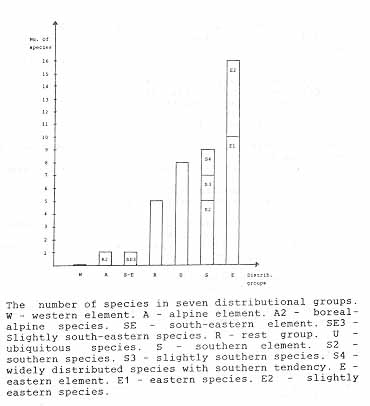Fennoscandia includes the four countries in northern Europe:
Norway, Sweden, Denmark, Finland.
For evaluation of the floristic distribution patterns within
Fennoscandia we use a system suggested by Bendiksen &
Halvorsen (1981) and
Okland & Bendiksen
(1985). This system includes vegetation zones as described by
Ahti et al. (1968). We have placed the species in groups
according to the overall appearance of their Fennoscandian
distribution patterns as far as it has been possible to ascertain
it.
There are no species in Norway belonging to the western
element.
| Factors that may influence the distribution of
species belonging to the southern element are: (1) the
distribution of the substrate. Several of the
lichens are restricted to deciduous trees having a
southern distribution in Fennoscandia e.g. Ulmus,
Fraxinus, and Quercus. (2) Low temperatures in
the summer or low temperatures in the winter may also be
delimiting. |
| The southern element is divided into four groups: |
| |
| S I Strongly southern species. No species
occur in this group. |
| |
| S Z Southern species. Five
species occur in this group: |
| Calicium adspersum |
| Calicium quercinum |
| Sclerophora farinacea |
| Sclerophora nivea |
| Sclerophora peronella |
| Species in this group occur in the temperate and
hemiboreal vegetation zones. |
| |
| S 3 Slightly southern species, including two
species: |
| Calicium corynellum |
| Chaenotheca carthusiae |
| Species in this group occur in the temperate,
hemiboreal, and south boreal vegetation zones. |
| |
| S 4 Widely distributed species with southern
tendency, also including two species: |
| Calicium glaucellum |
| Chaenotheca ferruginea |
| Species in this group occur in the temperate,
hemiboreal, south boreal, and middle boreal vegetation
zones. |
| |
| |
| South-eastern element |
| |
| High summer temperatures seem to be important for
species belonging to the south-eastern element, although
low winter temperatures cannot be disregarded. |
| The south-eastern element is divided into four
groups: |
| |
| SE 1 Strongly south-eastern species. No
species occur in this group. |
| |
SE 2 South-eastern species. No species in this
group.
| |
| SE 3 Slightly south-eastern species. |
|
| Chaenotheca phaeocephala |
| The species in this group occur as far north as the
Nordland province, and they may reach the inner fjords of
the Norwegian west coast. (In Sweden Chaenotheca
phaeocephala has been collected as far north as Lule
Lappmark). |
| |
| SE 4 Widely distributed species with south-eastern
tendency. No species occur in this group. |
| |
| |
| Eastern element Several
factors have been suggested as important for the
distribution of species in the eastern element: (1) The
distribution of the substrate. Some of the lichens (Chaenotheca
subroscida and Cyphelium karelicum) prefer Picea
which has aneastern distribution in Fennoscandia. (2)
Low humidity may be significant for some, but not for all
species. (3) The snow cover may influence some species.
(4) Competition, especially from bryophytes, may be of
considerable importance at the Norwegian west coast.
Species belonging to the eastern element fall into
different ecological groups. Calicium denigratum, C.
trabinellum, Cyphelium tigillare and Thelomma
ocellatum occur on dry lignum in exposed habitats,
while the other species grow under very humid or humid
conditions. They occur in root caves, on well decomposed
lignum of stumps, or they are corticolous in humid
forests. The eastern element is divided into two groups:
|
| E I Eastern species. This group includes 10
species: |
| Calicium adaequatum |
| Calicium denigratum |
| Chaenotheca gracillima |
| Chaenotheca laevigata |
| Chaenotheca subroscida |
| Chaenotheca sulphurea |
| Cyphelium karelicum |
| Microcalicium ahlneri |
| Microcalicium disseminatum |
| Sclerophora coniophaea |
| |
| E Z Slightly eastern species, including four
species. |
| Calicium trabinellum |
| Chaenotheca xyloxena |
| Cyphelium tigillare |
| Thelomma ocellatum |
| The species in group E 2 reach the inner fjords of
the Norwegian west coast while the species in group E 1
only reach the mountain chain. |
| |
| |
| Alpine element |
| |
| Species belonging here probably do not tolerate high
summer temperatures. |
| The alpine element is divided into three groups. |
| |
| A 1 Pronounced alpine species. No species
occur in this group. |
| |
| A 2 Boreal-alpine species. |
| Cyphelium pinicola |
| The species in this group are mostly distributed in
alpine areas, but may also occur in the boreal vegetation
zones. |
| Cyphelium pinicola grows in the most
continental areas of Norway. It seems to have a disjunct
distribution. The substrate (Pinus) is widely
distributed in Norway, and climatic factors must be
restricting the distribution of C. pinicola. |
| |
| A 3 Southern hemiboreal-alpine species. No
species occur in this group. |
| |
| |
| Ubiquitous species These
are widely distributed species in Fennoscandia.
|
| Calicium viride |
| Calicium salicinum |
| Chaenotheca brunneola |
| Chaenotheca chrysocephala |
| Chaenotheca furfuracea |
| Chaenotheca gracilenta |
| Chaenotheca stemonea |
| Chaenotheca trichialis |
| Cyphelium inquinans |
| |
| |
| Remainder Group These
species have been collected only a few times in
Fennoscandia and their distribution patterns are still
insufficiently known:
|
| Calicium abietinum |
| Calicium parvum |
| Calicium subquercinum |
| Chaenotheca cinerea |
| Microcalicium arenarium |


